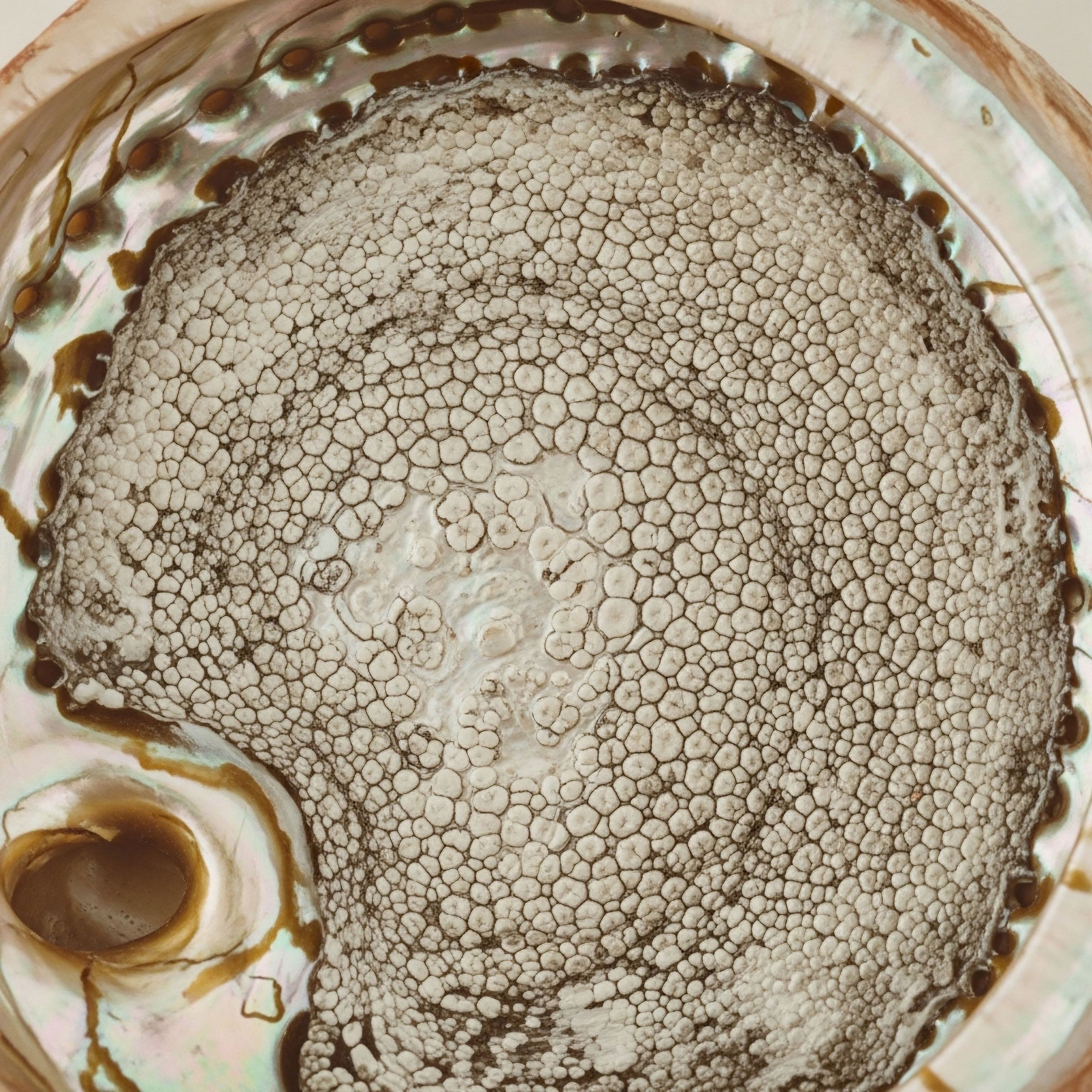

Fundamentals
Have you ever experienced a subtle shift in your daily rhythm, a persistent feeling of being slightly off-kilter, where your usual energy and clarity seem to diminish? Perhaps you notice a gradual decline in your physical resilience, a waning of your drive, or a change in your body’s composition that feels beyond your control.
These experiences are not merely signs of passing time; they often signal a deeper conversation happening within your biological systems, particularly your endocrine network. Your body possesses an intricate communication system, a complex web of signals and responses that orchestrate everything from your mood to your metabolic rate.
When this system operates optimally, you experience vitality and robust function. When imbalances arise, the effects can ripple throughout your entire being, impacting your well-being in ways that are deeply personal and often perplexing.
Understanding these internal dialogues is the first step toward reclaiming your inherent capacity for health. Many individuals seeking to restore hormonal balance or enhance metabolic function encounter discussions about therapeutic approaches. These often fall into two broad categories ∞ single-agent interventions and dual-mechanism therapies.
A single-agent approach focuses on introducing one specific compound to address a perceived deficiency or imbalance. This might involve administering a particular hormone to raise its circulating levels. While straightforward, this method sometimes overlooks the interconnected nature of the body’s regulatory systems.
The body’s hormonal network functions as a sophisticated communication system, where each signal influences many others.
Dual-mechanism therapies, conversely, recognize that biological systems rarely operate in isolation. They involve the simultaneous application of two or more agents, each designed to act on different, yet complementary, pathways within the body. This strategy aims to create a more comprehensive and harmonious recalibration of physiological processes.
Imagine your endocrine system as a finely tuned orchestra; a single-agent approach might adjust one instrument, while a dual-mechanism strategy seeks to harmonize multiple sections, ensuring a richer, more integrated performance. This deeper understanding of your biological systems allows for a more precise and effective path toward reclaiming vitality and function without compromise.
The distinction between these therapeutic philosophies becomes apparent when considering the body’s feedback loops. Hormones are not simply released into the bloodstream; their production and activity are tightly regulated by a series of checks and balances. When one hormone level changes, it can trigger a cascade of responses, influencing the production or sensitivity of other hormones.
A single intervention might correct one aspect, but it could inadvertently create imbalances elsewhere in the system. Dual-mechanism approaches, by targeting multiple points within these regulatory circuits, aim to anticipate and mitigate such unintended consequences, striving for a more balanced and sustainable outcome. This foundational understanding sets the stage for exploring specific clinical protocols and their implications for your personal health journey.


Intermediate
As we move beyond the foundational concepts, the practical application of hormonal optimization protocols comes into focus. The choice between a single-agent or dual-mechanism approach becomes particularly relevant when considering therapies designed to restore hormonal equilibrium. These protocols are not merely about replacing what is missing; they involve a strategic recalibration of the body’s internal messaging service, aiming for a more robust and resilient physiological state.

Testosterone Optimization Protocols for Men
For men experiencing symptoms associated with declining testosterone levels, such as reduced energy, changes in body composition, or diminished libido, Testosterone Replacement Therapy (TRT) often serves as a primary intervention. A single-agent TRT protocol typically involves the administration of exogenous testosterone, commonly as weekly intramuscular injections of Testosterone Cypionate. This directly elevates circulating testosterone levels, addressing the deficiency. However, this direct approach can sometimes lead to secondary effects within the intricate hormonal network.
The body’s hypothalamic-pituitary-gonadal (HPG) axis, a central regulatory pathway, responds to elevated exogenous testosterone by reducing its own production of luteinizing hormone (LH) and follicle-stimulating hormone (FSH). This suppression can lead to a decrease in endogenous testosterone production and, in some cases, testicular atrophy. To counteract these effects, dual-mechanism strategies often incorporate additional agents.
A common dual-mechanism protocol for men on TRT includes:
- Gonadorelin ∞ Administered via subcutaneous injections, often twice weekly. This peptide stimulates the anterior pituitary gland to release LH and FSH in a pulsatile manner, mimicking the body’s natural rhythm. This stimulation helps maintain testicular function, supporting endogenous testosterone production and preserving fertility. While Gonadorelin has a short half-life, requiring frequent administration or pulsatile pumps in some clinical studies, its inclusion aims to prevent the complete shutdown of the HPG axis that can occur with testosterone monotherapy.
- Anastrozole ∞ This oral tablet, typically taken twice weekly, acts as an aromatase inhibitor. Testosterone can convert into estrogen (estradiol) in the body through the aromatase enzyme. Elevated estrogen levels in men can lead to undesirable effects such as gynecomastia, water retention, and mood fluctuations. Anastrozole blocks this conversion, helping to maintain a healthy testosterone-to-estrogen balance and mitigating potential side effects associated with increased estrogen.
- Enclomiphene ∞ In certain cases, Enclomiphene may be included. This selective estrogen receptor modulator (SERM) works by blocking estrogen receptors in the hypothalamus and pituitary, thereby signaling these glands to increase LH and FSH production. This further supports the testicles’ ability to produce testosterone naturally, making it particularly useful for men who wish to maintain fertility or recover endogenous production post-TRT.
This multi-agent approach, combining direct testosterone replacement with agents that modulate the HPG axis and manage estrogen levels, represents a more comprehensive strategy. It aims not only to alleviate symptoms of low testosterone but also to preserve aspects of natural endocrine function and mitigate potential adverse effects that might arise from a single-agent intervention.
The goal is to achieve a more physiological balance, akin to fine-tuning multiple components of a complex electrical grid to ensure stable power delivery.

Hormonal Balance for Women
Women navigating hormonal changes, particularly during peri-menopause and post-menopause, often experience a spectrum of symptoms, including irregular cycles, mood shifts, hot flashes, and reduced libido. While estrogen and progesterone are traditionally the primary focus of hormonal support for women, the role of testosterone is increasingly recognized. Testosterone, produced in smaller quantities by a woman’s ovaries and adrenal glands, contributes to bone strength, energy levels, and sexual drive.
A single-agent approach might involve estrogen-only therapy, particularly for women who have had a hysterectomy. However, for women with an intact uterus, progesterone is essential to protect against endometrial hyperplasia. This leads to a foundational dual-mechanism approach of combined Menopausal Hormone Therapy (MHT) with estrogen and progestogen.
Expanding on this, a more comprehensive dual-mechanism protocol for women might include:
- Testosterone Cypionate ∞ Administered typically as 10 ∞ 20 units (0.1 ∞ 0.2ml) weekly via subcutaneous injection, or through long-acting Pellet Therapy. This addresses symptoms like low libido, fatigue, and muscle mass changes. Research indicates that testosterone, alongside progesterone, can stimulate muscle protein synthesis in postmenopausal women, a benefit not observed with estradiol alone.
- Progesterone ∞ Prescribed based on menopausal status, often as micronized progesterone. This hormone is vital for endometrial protection in women with an intact uterus and contributes to mood stability and sleep quality. Its inclusion alongside estrogen and testosterone helps to create a more complete hormonal profile, addressing multiple physiological needs.
- Anastrozole ∞ When appropriate, especially with higher testosterone doses or in specific clinical contexts like breast cancer survivors, Anastrozole may be used to manage potential conversion of testosterone to estradiol. This ensures that the benefits of testosterone are maximized without leading to undesirable estrogenic effects.
This multi-hormone approach acknowledges the interconnectedness of female endocrine function, providing a more tailored and effective pathway to symptom relief and improved quality of life. It recognizes that hormonal balance is not a singular target but a dynamic interplay of several key biochemical messengers.

Growth Hormone Peptide Therapies
Beyond traditional hormone replacement, peptide therapies offer another avenue for dual-mechanism interventions, particularly in the realm of growth hormone optimization. Rather than introducing exogenous human growth hormone (HGH), these peptides stimulate the body’s own pituitary gland to produce and release HGH naturally. This approach respects the body’s physiological feedback mechanisms, reducing the risk of pituitary suppression seen with direct HGH administration.
Key dual-mechanism peptide combinations include:
| Peptide Combination | Primary Mechanism | Reported Benefits |
|---|---|---|
| Sermorelin + Ipamorelin | Sermorelin (a GHRH analog) stimulates GH release from the pituitary. Ipamorelin (a GHRP) enhances this release by targeting specific receptors, without significantly raising cortisol or prolactin. | Improved sleep quality, enhanced fat loss, increased muscle mass, better recovery, anti-aging effects, and improved vitality. |
| CJC-1295 + Ipamorelin | CJC-1295 (a GHRH analog with a longer half-life) provides a sustained release of GH. Ipamorelin offers a pulsatile, selective GH release. Their combined action creates a synergistic effect for robust GH and IGF-1 elevation. | Significant fat loss (especially abdominal), muscle growth, accelerated recovery, improved bone density, enhanced cognitive function, and anti-aging benefits. This combination is often preferred for maximizing fat burning and muscle gain due to sustained GH elevation. |
Other peptides, such as Tesamorelin and Hexarelin, also contribute to growth hormone modulation, while MK-677 (Ibutamoren) acts as a growth hormone secretagogue, increasing GH and IGF-1 levels through different pathways.
The strategic combination of these peptides leverages their distinct mechanisms of action to achieve a more comprehensive and sustained elevation of growth hormone, supporting anti-aging, muscle gain, fat loss, and sleep improvement. This targeted stimulation of the body’s own systems represents a sophisticated dual-mechanism approach to metabolic and regenerative health.
Combining growth hormone-stimulating peptides offers a synergistic effect, enhancing natural production without suppressing the body’s own systems.

Targeted Peptides for Specific Functions
Beyond broad hormonal and metabolic support, specific peptides offer dual-mechanism potential for highly targeted physiological functions. These agents often interact with unique receptor systems to elicit precise biological responses.
- PT-141 (Bremelanotide) ∞ This peptide primarily addresses sexual health. It works by activating melanocortin receptors in the brain, directly influencing sexual desire and arousal in both men and women. Unlike traditional medications for erectile dysfunction that focus on blood flow, PT-141 acts on the central nervous system to enhance the neurological aspect of sexual arousal. Its non-hormonal mechanism makes it a distinct dual-mechanism option, as it can be combined with other therapies without directly altering circulating hormone levels. Clinical studies have shown its effectiveness in treating erectile dysfunction and hypoactive sexual desire disorder.
- Pentadeca Arginate (PDA) ∞ This scientifically engineered peptide is recognized for its role in tissue repair, healing, and inflammation modulation. Derived from a protein found in the stomach, PDA supports the body’s natural processes for building muscle, reducing fat, and improving overall cellular function. It has demonstrated the ability to accelerate the healing of wounds, tendons, and ligaments, reduce inflammation, and protect organs. Its dual action on tissue regeneration and anti-inflammatory pathways makes it a valuable component in recovery and restorative protocols.
These specialized peptides exemplify how dual-mechanism therapies can extend beyond endocrine system recalibration to address specific physiological needs, offering precise interventions that complement broader wellness strategies. The deliberate selection and combination of these agents allow for a highly personalized and effective approach to optimizing health outcomes.


Academic
The exploration of dual-mechanism therapies necessitates a deep dive into the intricate biological architecture that governs human physiology. At an academic level, understanding how these multi-agent protocols interact with the body’s complex signaling networks reveals their profound potential for restoring systemic balance. The endocrine system, far from being a collection of isolated glands, operates as a highly integrated communication network, where each component influences and is influenced by others.

The Hypothalamic-Pituitary-Gonadal Axis Recalibration
The Hypothalamic-Pituitary-Gonadal (HPG) axis stands as a prime example of a sophisticated feedback loop. The hypothalamus releases Gonadotropin-Releasing Hormone (GnRH), which stimulates the pituitary gland to secrete Luteinizing Hormone (LH) and Follicle-Stimulating Hormone (FSH). These gonadotropins then act on the gonads (testicles in men, ovaries in women) to produce sex hormones like testosterone and estrogen. These sex hormones, in turn, provide negative feedback to the hypothalamus and pituitary, regulating their own production.
In the context of male Testosterone Replacement Therapy (TRT), a single-agent approach with exogenous testosterone directly suppresses LH and FSH production, leading to testicular quiescence. This can result in testicular atrophy and impaired spermatogenesis. A dual-mechanism strategy, incorporating agents like Gonadorelin and Anastrozole, aims to mitigate these effects by modulating the HPG axis.
Gonadorelin, as a GnRH analog, provides pulsatile stimulation to the pituitary, encouraging the continued release of LH and FSH. This maintains testicular activity, preserving both size and fertility potential, a critical consideration for many individuals. The short half-life of Gonadorelin necessitates precise administration to mimic natural pulsatility, highlighting the biochemical precision required for optimal outcomes.
Simultaneously, Anastrozole addresses the metabolic fate of exogenous testosterone. Testosterone is aromatized into estradiol, and while some estrogen is essential for male health, excessive levels can lead to adverse effects and further suppress the HPG axis. By inhibiting aromatase, Anastrozole ensures that the benefits of elevated testosterone are not undermined by disproportionate estrogen levels, thereby supporting a more favorable hormonal milieu.
This multi-pronged intervention respects the inherent complexity of the HPG axis, aiming for a more harmonious systemic recalibration rather than a simple, isolated adjustment.

Synergistic Peptide Action in Growth Hormone Modulation
The realm of growth hormone optimization provides another compelling illustration of dual-mechanism efficacy. While direct administration of recombinant human growth hormone (HGH) can elevate circulating levels, it bypasses the body’s natural regulatory mechanisms, potentially leading to pituitary desensitization and other complications. Peptide therapies, conversely, represent a more physiological approach by stimulating the body’s own production of growth hormone.
The combination of CJC-1295 and Ipamorelin exemplifies this synergistic action. CJC-1295 is a Growth Hormone-Releasing Hormone (GHRH) analog with a prolonged half-life, providing a sustained signal to the pituitary gland to release growth hormone. Ipamorelin, a Growth Hormone-Releasing Peptide (GHRP), acts on different receptors within the pituitary, specifically stimulating GH release without significantly increasing cortisol or prolactin, which are common side effects of other GHRPs.
| Agent | Primary Mechanism of Action | Systemic Impact |
|---|---|---|
| Testosterone Cypionate | Exogenous androgen replacement; binds to androgen receptors. | Directly increases circulating testosterone levels, influencing muscle mass, bone density, libido, and mood. |
| Gonadorelin | Stimulates pulsatile release of LH and FSH from the anterior pituitary. | Maintains endogenous testicular function, supporting natural testosterone and sperm production, preventing atrophy. |
| Anastrozole | Aromatase inhibitor; blocks conversion of androgens to estrogens. | Manages estrogen levels, preventing estrogenic side effects and optimizing testosterone-to-estrogen balance. |
| CJC-1295 | Long-acting GHRH analog; stimulates pituitary GH release. | Provides sustained elevation of growth hormone and IGF-1, supporting tissue repair, fat metabolism, and muscle growth. |
| Ipamorelin | Selective GHRP; stimulates pituitary GH release without affecting cortisol/prolactin. | Enhances pulsatile GH release, promoting deep sleep, recovery, and lean body mass. |
| PT-141 | Melanocortin receptor agonist; acts on central nervous system. | Directly influences sexual desire and arousal, independent of hormonal pathways. |
When combined, CJC-1295 provides the sustained background signal, while Ipamorelin delivers the physiological “pulses” of growth hormone. This dual action leads to a more robust and consistent elevation of Insulin-like Growth Factor 1 (IGF-1), the primary mediator of growth hormone’s anabolic effects.
The result is enhanced fat metabolism, increased lean muscle mass, improved recovery, and a more youthful cellular repair capacity, all achieved while preserving the integrity of the body’s own endocrine feedback loops. This intelligent combination reflects a deep understanding of neuroendocrinology and metabolic pathways.
Dual-mechanism peptide therapies stimulate the body’s own growth hormone production, offering a more physiological and safer alternative to exogenous HGH.

Interconnectedness of Hormonal and Metabolic Pathways
The academic perspective on dual-mechanism therapies extends to their impact on broader metabolic health. Hormones are not merely regulators of reproductive function; they are deeply intertwined with metabolic processes, inflammation, and even cognitive function. For instance, testosterone deficiency in men is often associated with metabolic syndrome, insulin resistance, and increased cardiovascular risk. Similarly, hormonal shifts in women during menopause can influence lipid profiles, bone density, and mood stability.
A single-agent approach might address one symptom, but a dual-mechanism strategy considers the systemic ripple effects. For example, in women, the combination of Testosterone Cypionate and Progesterone not only addresses symptoms like low libido and hot flashes but also exerts direct effects on muscle protein synthesis and bone health.
Progesterone, beyond its role in endometrial protection, contributes to neurosteroid pathways, influencing mood and sleep architecture. This multi-hormone intervention acknowledges the complex interplay between sex steroids and overall metabolic resilience.
The strategic use of peptides like Pentadeca Arginate (PDA) further illustrates this interconnectedness. PDA’s ability to promote tissue repair and reduce inflammation has implications for metabolic health, as chronic low-grade inflammation is a known contributor to insulin resistance and other metabolic dysfunctions. By supporting cellular repair and modulating inflammatory responses, PDA can indirectly contribute to improved metabolic function, demonstrating how targeted peptide interventions can complement broader hormonal optimization efforts.
The decision to employ dual-mechanism therapies is rooted in a comprehensive understanding of human physiology, recognizing that optimal health arises from the harmonious function of interconnected systems. This approach moves beyond simplistic symptom management, aiming instead for a deep, systemic recalibration that supports long-term vitality and well-being. It represents a commitment to precision and a respect for the body’s inherent intelligence, guiding individuals toward a more integrated and resilient state of health.

References
- Clinical efficiency of combination therapy using testosterone replacement therapy, phosphodiesterase 5 inhibitors and Kampo herbal medicine for eugonadal patients with late-onset hypogonadism syndrome.
- Gonadorelin for Men on Testosterone Replacement Therapy (TRT).
- Does gonadorelin work?
- Testosterone Maximizing Therapy (TMT) ∞ Increase Testosterone Production & Fertility for Men.
- Gonadorelin – Benefits, Dosage & Side Effects | GeneMedics.
- Testosterone for Women ∞ Hormone Replacement Therapy – Atlantic Urology Specialists.
- Bioidentical Hormone Pellet Therapy for Women – Women’s Wellness Center.
- Combined Menopausal Hormone Therapy (MHT).
- Testosterone and Progesterone, But Not Estradiol, Stimulate Muscle Protein Synthesis in Postmenopausal Women – PMC – PubMed Central.
- Types of hormone replacement therapy (HRT) – NHS.
- Growth Hormone Stimulating Peptide Therapy – Fort Myers & Naples – Contemporary Health Center.
- Sermorelin vs. CJC-1295 vs. Ipamorelin ∞ Comparing Popular Growth Hormone Peptides.
- Ipamorelin + CJC-1295 ∞ Peptide Combo Explained for Growth and Recovery – Swolverine.
- Anti-Aging Peptide Therapy ∞ The Top 12 Questions Answered – Rejuvenated Medical Spa.
- CJC-1295 vs. Sermorelin ∞ Which Peptide is Best for Growth Hormone Stimulation? – TRT MD.
- PT-141 (Bremelanotide) Therapy in Germantown, WI – Forward Healthy Lifestyles.
- What is PT 141? – Wittmer Rejuvenation Clinic.
- Novel Emerging Therapies for Erectile Dysfunction – PMC – PubMed Central.
- Why PT 141 is Best for Female Arousal and Sexual Desire – Wittmer Rejuvenation Clinic.
- Double-blind, placebo-controlled evaluation of the safety, pharmacokinetic properties and pharmacodynamic effects of intranasal PT-141, a melanocortin receptor agonist, in healthy males and patients with mild-to-moderate erectile dysfunction – PubMed.

Reflection
Your personal health journey is a dynamic process, a continuous dialogue between your internal biological landscape and the external world. The insights shared here regarding dual-mechanism therapies are not prescriptive endpoints but rather guideposts on a path toward deeper self-understanding.
Recognizing the interconnectedness of your hormonal and metabolic systems is a powerful step, transforming vague symptoms into meaningful signals. This knowledge empowers you to engage with your health proactively, moving beyond a reactive stance to one of informed partnership with your body.
Consider this exploration a starting point, an invitation to introspection. What sensations or shifts have you observed within your own system? How might these observations align with the intricate biological principles discussed? The path to reclaiming vitality is highly individualized, demanding careful consideration of your unique physiology, lifestyle, and aspirations. True wellness is not a destination but a state of dynamic equilibrium, constantly refined through thoughtful action and personalized guidance.
This journey toward optimal function is a testament to the body’s remarkable capacity for adaptation and healing when provided with the right support. Your commitment to understanding these complex systems is a commitment to your own potential, allowing you to move forward with clarity and purpose.



